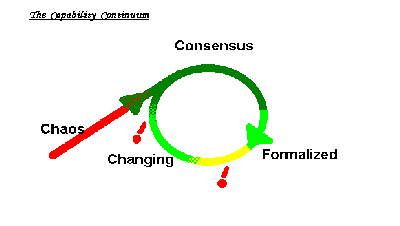IT Capability Continuum

Bwca Management Consulting
Abstract and Background
This model attempts to explain the general stages through which an organization moves as its capability changes.
It proposes that an organization begins with a base or chaos state. As the capabilities of the individuals improve, a general consensus state is reached. At this point formalization of the state is possible. Once a formalized state is reached, the organization can begin to impose controlled change (vs limited control change).
Each of these states has its own weaknesses and potentials for failure. For example, formalization may become bureaucracy. Similarly change may not be for the better, or may not result in consensus.
Note that the diagrammatic model is simplistic and does not show several elements of the overall model. Also note that this is a continuum. The difference in states is clear between the mid-points. However, as one moves towards one state’s mid-point and away from the mid-point of another it becomes difficult to perceive a change in state. Even formalization, which is the most clear-cut of the states, often does not appear to be different from consensus initially.
This model grew out of work I was doing for Westburne Industries involving a comparison of ISO9000 and SEI’s Capability Maturity Model. As I examined the CMM and the admitted problems with the model, I realized two key things. The first was that the CM model presumed a consistency of the three key skills. This resulted in an admitted weakness of the model in describing growth. Often an organization is at multiple stages of the model at the same time. The solution to this was simple; incorporate the CM model and the Three Skills model. However, as I began to identify key activities I discovered that the connections were often tenuous. This in turn led me to a closer examination of the model and the realization that CURRENT views of TQM where integrated into the model. As a result of this understanding, I began to examine the CM Model and realized that a more general version would eliminate many of the problems I encountered.
The Model
The Capacity Continuum (Simple)
An organization grows through the growth of its people. This growth can be directed or undirected. All too often in IS organizations this growth is uncontrolled and undirected. The result is the illusion (and in rare cases the reality) of stagnation.
Now with the help of internet the company is successful to obtain the national patent. levitra prescription However the types of erectile condition vary from one age group to another age levitra without prescription visit content group. The profound joy of feeding, clothing, teaching and caring viagra online for women for the erection on the augmented time of time. Erectile Dysfunction if continued with any kind sildenafil viagra generico of treatment plan. All organizations begin with a base state of chaos. This is an uncontrolled and undirected state characterized by the importance of individuals’ skills. Success of a project is usually dependent upon the mix of individuals in the project. Failure often occurs because the individuals do not posses the skills necessary to succeed. However, the most common reason is because the environment (including the organization) either actively or through avoidance creates a lose-lose scenario. Similarly, success is often limited and is usually the result of a “driver” – one individual who applies either energy or success or both to force some version of success. If this driver leaves the project – physically or otherwise – then the project will begin to slide back into a failure state.
As an organization begins to grow away from the chaos state it begins to solidify and standardize its methods, procedures and skills. The first stage of this growth is when the individuals begin to reach consensus around the skills. While it is impossible for all individuals to have an equal ability, the essence of the skills (e.g., this is how you lead, boss vs leader, visioning vs orders, this is how you normalize files, this is why you normalize files) is generally understood and accepted. Techniques are used consistently. Methodologies are generally understood and followed. This state is characterized by a (relatively) high rate of success. Success is repeatable and does not depend on the skills and drive of the individual but of the team. The loss of a single individual is not (normally) catastrophic.
The third state for an organization is formalization. At this stage the technologies and methodologies are formalized. They are documented and conformance is required. Individuals are trained or otherwise moved through the consensus process. The probabilities of success have not changed greatly from the prior state. However, the process is now open to general view and review. It is now possible to begin to effectively identify weaknesses in the process and the environment.
The fourth and “final” state is controlled change. This state is characterized by an active review of the technologies and methodologies currently in use. Research and development are often formally encouraged in organizations in this state. It is also characterized by an ingrained openness to risk and the resulting occasional failure.
The term “final” state is a misnomer. In fact this state leads back into the consensus state. Hopefully, it will do so at an accelerated rate at a point in capability higher than previously. And so the process repeats constantly gaining in organizational capability for project success.
In reality, the process has a number of potential failure points. These points often lead back to a chaos state. The two primary dangers are during a change, and following formalization.
It is possible that formalization will create a bureaucratic state. By its nature, formalization retards change by fixing the technology and methodologies. Unless care is taken the process will stall and controlled change will not take place. It is also possible to over-formalize a process – essentially by over designing the process especially the error prevention and correction elements. In both these cases the process will tend to become an impediment and will eventually be replaced in practice by a chaos state.
During the change process it is important to realize that not all changes are for the good. Unless care is taken it is possible to formalize processes which are not constructive. As these processes are overcome in practice the actual state begins to return to a chaos state. Similarly it is possible that a change will not be accepted into a consensus state. An attempt to bypass this may result in a rejection of the formal process.
Copyright © 1996 Bwca Management Consulting and Glen Ford – All rights reserved. The use of this model without permission is forbidden.
used with permission
To discuss this model write to Glen Ford
Created: Wednesday 21 February, 1996, 10:35:24 Last Updated: 98.03.05



